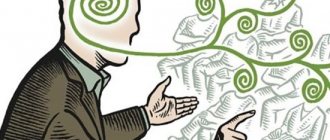Ideas rule the modern world. The one who can generate fresh thoughts wins. One of the secrets of how to set trends lies in developed associative thinking.
In this article we will tell you:
- What is associative thinking
- Types of associative thinking
- What are the benefits of associative thinking?
- Game exercises for the development of associative thinking
"Don't think about the white rabbit!" - and we immediately start thinking about him and everything connected with rabbits. We remember the most famous rabbits from cartoons and fantasy. Perhaps a story from childhood comes to mind when, while walking with our parents, we took pictures in the park with furry animals. Or an image appears before your mind's eye, because of which rabbits now evoke bad associations.
What is associative thinking
Associative thinking - what is it? It is a verbal connection between two or more concepts. The subconscious mind works with information entering the brain without using the ability to conduct logical analysis. Associative thinking is associated with the perception of the surrounding world, the ability to make decisions and generate ideas. Its development depends on the attention, memory, and life experience of each individual.
What associative thinking is can be shown with an example. Let's say you met some new object or person. At this moment, your brain begins to actively operate. It compares what you just learned with what you knew before. At the same time, he creates associations. The next time you meet an object, you will recognize it thanks to the associations already fixed in the subconscious. The more of them there are, the easier it is for you to remember and analyze the situation.
And now a clear example. Imagine a person who saw the northern lights for the first time in his life. He compares it to something familiar, like fireworks or lightning. The sound that accompanies the phenomenon is similar to the crackling of wood in a stove. And so on. Having met a new acquaintance, a person will note that his voice is similar to that of a colleague. The face shape is the same as that of one of the relatives, and the gait is like that of a close friend.
What are associations?
Association is a connection between individual facts, events, objects or phenomena reflected in a person’s mind and fixed in his memory. Associative perception and thinking of a person lead to the fact that the appearance of one element under certain conditions evokes the image of another associated with it.
The ability to make associations is the most important ability of our mind. There is even such a direction: associative psychology (or associationism), which tries to explain a person’s mental processes by studying his associations in connection with certain objects (stimulus - response); the process of memorizing information can also be considered from this point of view.
Types of associations
According to the associative theory of thinking, different senses are involved in creating associations. Therefore, when a person hears a word, he almost instantly associates it with some object. For example, the characteristics “sweet”, “airy”, “creamy” remind him of a cake.
There are several types of associations:
- Contrasting, opposite to each other: fire and ice.
- Similar in meaning: veterinarian - doctor.
- General or generalized: lemon - citrus fruits.
- Those that subordinate other concepts: part - cog.
- Related concepts close to each other in time and space: meat - cow.
- Speaking about individual parts of the whole organism: eyes - face.
- Cause-effect associations: rain - umbrella.
- One word complements the other: porridge - butter.
There are other types of associations. They differ from each other in the method and conditions of use. They may have the same root (gloomy - gloom), be related phonetically (bump - bud) or relate to the same topic (cocktail - bar).
Associative theory of thinking
The first ideas about the universal laws of human mental life were associated with the formation of associations . In the 17th century, the psychology of thinking had not yet been identified as a separate section, and thinking was not considered as a special form of human activity. The development of thinking was understood as a process of accumulation of associations.
The associative theory of thinking is one of the earliest. Its supporters believed that thinking is an innate ability and comes down to associations connecting traces of the past and impressions of present experience. Unfortunately, this theory could not explain the creative nature of the thinking process, the specificity of its content and the patterns of its occurrence.
However, based on the learning process, the associative theory of thinking highlighted several very significant points for the development of thinking:
- The importance of using visual material in the learning process;
- The realization that learning is possible only through sensory knowledge, i.e. through images and representations.
- Understanding that associations expand the boundaries of abilities, through them consciousness is stimulated, activating the processes of comparison, analysis, and generalization.
Scope of application
Imaginative or associative thinking contributes to better assimilation of new information. You will be able not only to generate creative ideas, but also to actively implement them. This will help you achieve success in work and school.
Associative thinking is most useful to people in creative professions. We are talking about musicians, actors, writers. Marketers also use it. They need associations in order to make buyers want to purchase a particular product. They create the most simple but memorable images. And you, without noticing it, go to the store for the next new product.
Types
They are distinguished by:
- similarities: sled – skis – snowboard.
- contrast: white - black, boy - girl.
- the relationship between the whole and its parts: finger - nail, phone - screen.
- cause-and-effect relationship: clouds - rain, fire - fire.
- generalization: shoes are footwear, earrings are decoration.
- subordination: watermelon - berry, maple - tree.
- contiguity of space or time: winter - cold, newspaper - magazine.
- addition: butter - salad, soup - bread.
Benefits of Associative Thinking
Imaginative thinking helps in solving problems both in everyday life and in work, study, etc. This is just one of its advantages. There are a number of others:
- Promotes the development of imagination. As stated above, you will be more likely to have unusual but interesting ideas. It will also make it easier for you to be creative.
- Improves memory. Long associative chains are built in the brain, which allow you to remember a large amount of new material.
- Increases productivity. Everything is clear here. If you assimilate new information faster, you will complete the tasks assigned to you faster and better.
- Improves brain function. Another feature of associative thinking. During the construction of an associative series, new bundles of neurons appear in the brain.
- Makes it easier to understand. It is easier for you to perceive new data and connect it with the information you already know.
Another undeniable advantage is the opportunity to get to know your inner “I” better. According to Sigmund Freud, associations reveal what is hidden deep in a person's subconscious. Using associative thinking, you may discover information in yourself that will help change your life.
You can clearly see the benefits of associative thinking using examples. Engineer Brown, who was building bridges, once saw a cobweb under a bush. This prompted him to create a suspension bridge, the fastenings for which were cables.
Or remember Georges de Mestral, the creator of Velcro. He came up with it after examining the structure of burdock spines under a microscope. And he took it off his dog in abundance after every walk.
Completion
Engage in self-development, because it will provide you with a happy and successful future. Let’s say it wouldn’t be superfluous to pay attention to the development of non-standard thinking.
At a minimum, it will help you notice the obvious that is inaccessible to understanding due to existing stereotypes and personal limitations. And this skill, by the way, has allowed many individuals to make brilliant discoveries. So go for it and everything will work out for you!
And subscribe to the blog so as not to miss new and useful articles to broaden your horizons and develop awareness.
The material was prepared by psychologist, Gestalt therapist, Alina Zhuravina
Associative thinking disorders
Deviations in the process of associative thinking are manifested in changes in its speed, focus, and correctness. Each group of disorders has several subtypes.
By change of tempo:
- A person processes information quickly. He also quickly and impulsively generates new ideas and makes decisions. Most often this is a sign of manic states.
- The speed of thinking slows down. Thinking about solutions to the problem takes a lot of time.
- Extraneous thoughts are introduced into the process, which interfere with the construction of associative chains. As a result, people get off topic.
- Due to the interruption of thoughts, thinking stops.
By liveliness:
- In the process, a person mentions too many minor details, unnecessary details.
- Many additional associations and nuances are given.
- Associative thinking becomes “sticky” and unproductive. The thread of the conversation is lost.
For grammar:
- In a conversation, a person speaks in cliched phrases, uses stereotypes and cliches.
- Words, sounds and phrases that are completely meaningless are constantly repeated.
- The interlocutor repeats incoherent, logically and grammatically incorrect phrases.
The largest system for classifying disorders of associative thinking is by purposefulness. There are more than 10 types:
- A simple thought is expressed in a florid way.
- When discussing a topic, a person begins to reason and uses inappropriate associations. But then he returns to the conversation.
- The conversation is about nothing. Empty words without a specific topic.
- The conversation is formal. The problem remains unresolved.
- It is impossible to make a final decision because a lot of time is spent studying different points of view, opinions, and assessments.
- It is impossible to understand what a person wants to say, because each subsequent word contradicts the previous one. This phenomenon is called amorphism.
- Not only associative, but also logical thinking is impaired. This makes it difficult to establish connections between concepts or objects.
- A person uses symbols that are understandable only to him.
- New meaning appears in words. This happens if the interlocutor attaches meaning, for example, to the number of letters or how a word rhymes with others.
- Autistic thinking. A person thinks only about what is inside him. And this world is closed to others.
- Archaic thinking. It is based on old-fashioned patterns, stereotypes, views that have nothing to do with the real state of affairs.
- Perseveration. A person persistently repeats the same phrase or word, even if it is no longer relevant to the conversation.
And finally, the last violation of associative thinking is disconnection. The sentences are constructed correctly. But there is no logic at all in the reasoning and conclusions.
Some general information
Each person’s associations with one word or event are completely different. This happens due to the life experience that is behind us. For example, when hearing the word “sun,” someone may smile joyfully, remembering the happiest day when the sun was shining brightly and it was warm. And someone, on the contrary, will frown, remembering how he got burns in the summer, in addition to sunstroke due to falling asleep on the beach.
And also due to the difference in the leading representative system. Let me briefly remind you that there are auditory learners; it is easier for them to remember and perceive information by ear. Kinesthetics, they do this with the help of sensations and touches. Visual people rely on their vision, it is important for them to see, only then will they be able to notice and remember something. And also a rare type of digitals, they combined all the features of the representative system, taking a little from each type.
So, we build associations depending on what organs of perception we use to perceive this world and exist in it. Let's say that to learn a phone number, you just need to say it out loud several times. But another person will not be able to reproduce it until he writes it down on a piece of paper, or imagines each number in his head.
How to develop associative thinking
Associative thinking, like other types of thinking, can be developed. The main requirement in this matter is to regularly train by performing a series of simple exercises.
Work with children
It is better to develop this type of thinking from childhood. It is easier for children than adults to establish connections between objects, events and phenomena. How can we help them develop the ability to think in associations?
First, tell your child about the objects that surround him and what he can do with them. Then move on to generalization. For example, explain that plates, cups, pots are all dishes, and a sofa, cabinet and chair are furniture.
These exercises are suitable for young children. For those who are older, more complex tasks are needed. Invite your child to determine the correct sequence of objects or find one common feature in them.
Remember that associations will not always be positive. Sometimes children react sharply to one image or another. For example, they associate a white coat with a doctor, and the doctor himself with an injection, etc. Such associations are called suppressed. We need to get rid of them.
Exercises for adults
Regularly performing simple exercises will help you learn how to quickly create associative chains and remember information that is new to you.
- Take 2 words that are in no way related to each other. Create associations between them.
- Come up with 1 word with which you will begin building an associative chain. Select associations for it as long as you can.
- For this exercise, let's have 3 words. Select associations that match these words in some way. For example, you selected “bright” and “hot”. Think about what objects or phenomena might have such characteristics.
- For several initial words, select associations that suit each of them.
- Take 1 word and select an unusual association for it, which, at first glance, has nothing to do with it.
- Think about one of your friends. Choose a song that describes him best. Let this be the first thing that comes to mind. You can also turn on the radio or your favorite playlist, close your eyes and observe the associations that arise in your mind.
- Brainstorm. What it is? Take a piece of paper and write down on it all the words that come to your mind. Read the entries. Think about how these words are related to each other. Naturally, some of them will baffle you. Don't be scared and don't stop. Try to figure it out.
These are exercises for the development of associative thinking that you can do independently. There are also those that can be done in a group, for example, among friends:
- The presenter comes up with a word. Participants take turns naming the associations they evoke. At the same time, they need to create an associative chain. Each new word must be connected with the previous one in meaning.
- In this exercise, the meaning remains the same: you need to come up with associations for the original word. Only this time not direct, but indirect. A person must name the image that arises precisely in his subconscious. Even if it does not have a direct relationship to the object.
The last stage is discussion. Let each participant tell what caused this or that association and why he named it. This will help you look inside yourself and get to what is stored deep in the subconscious.
Psychological use of associations
In psychology, the development of an associative type of thinking plays an important role, since it not only increases a person’s general abilities to study, process and remember information, but is also used as a method for studying deep psychological problems and personal qualities.
It should be noted that the associative research method first appeared in the psychoanalysis of Freud, who developed and used in his practice the meaning of uncontrolled associations and their chains as a direct projection of deep internal, often unconscious problems.
Let's present a test that will help you look into your subconscious and identify the most troubling problems:
- write down the first 16 words that come to mind. This will give you the first associative array;
- then select several words (from the associative row), connect them in pairs and come up with a word association for each pair. So you will get a row of 8 words;
- connect the words again and get a new associative string of 4 words and 2 words.
The last word of association is considered the most important in personality psychology at the moment. Look at him carefully - you practically “pulled” him out of your subconscious. Think about why this particular word has such an impact on you.
Photo by Massimo Virgilio on Unsplash
Let's give an example of an associative series for the word “Spring”:
- out of 16 words we got 8: dirty, damp, flowers, fresh grass, asphalt, heels, fatigue, stress;
- we take words in pairs in random order and select 4 words: apathy, summer is coming, joy, busyness;
- 2 words remain: vacation, stress. As a result, the word “Session” appears.
With such associations we were able to “pull out” the most exciting question. As soon as you realize it, you can level it out by consciously working through the problem. Just think about the fact that a session is just a 2-3 week period of life during which you need to work more.
The technique also works with more serious problems than passing a session or making decisions. It allows you to “remove” disturbing thoughts, call out from the subconscious what contributes to increased blood pressure or heart rate fluctuations. At the same time, after working through the associative series, you will not even understand what problem your subconscious “pulled out”, but psychologically and physiologically you will feel relief.
Recommendations
You need to exercise every day. The ideal option is a lesson lasting about 2 hours. It is recommended to start developing associative thinking with 20 minutes a day. Gradually increase the time.
Remember that bright, unusual, memorable associations work best. It is important that they are not only interesting. Let them touch all your senses. Associate objects and phenomena with smells, shapes, colors, etc.
According to psychologists, women have better developed associative thinking than men. Therefore, representatives of the stronger sex sometimes need help. Special creative notebooks have been developed for this purpose. By completing tasks in them, you can significantly improve your ability to build associative connections.
The story of how associative thinking helped Marina quickly remember new information
During my school days, I was always nervous about tests or simply cumbersome assignments that required me to memorize a lot of material. I was never able to remember everything completely; something always slipped out of my memory.
At that time, a new girl, Marina, transferred to our school. She and I quickly became friends, and before the next independent work, I complained that I had trouble remembering material from textbooks. To my surprise, Marina enthusiastically began to help me. But it is worth noting that she never had problems with her studies, her memory did not let her down. Sometimes it seemed to me that Marina knew the answers to all the questions.
When we met a week before independent work, Marina brought me several incomprehensible drawings and said that from today we would develop associative thinking together. The memory training she promised me turned into an association game. And the material for that very independent game served as a “field” for the game.
And indeed, with the help of associations, everything is remembered much easier and faster! I didn't notice how the week passed. Marina and I, who read the material only once during the entire period, wrote an excellent independent work. Since then, she has helped me develop associative thinking, and I have never encountered problems in my studies again.











